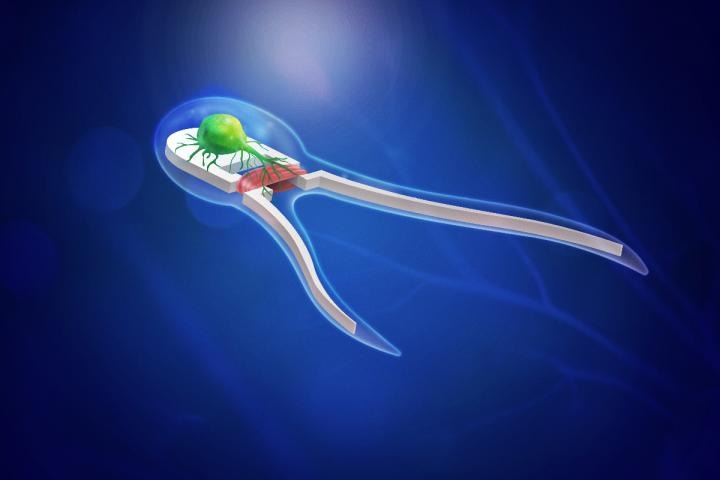Sep 17 2019
Scientists have brought mechanical engineering a step closer to creating autonomous biobots. They achieved this by developing soft robotic devices powered by neuromuscular tissue that triggers upon being stimulated by light.
 This is an artist rendering of a new generation of biobots—soft robotic devices powered by skeletal muscle tissue stimulated by on-board motor neurons. (Image credit: Michael Vincent)
This is an artist rendering of a new generation of biobots—soft robotic devices powered by skeletal muscle tissue stimulated by on-board motor neurons. (Image credit: Michael Vincent)
In 2014, research groups headed by mechanical science and engineering professor Taher Saif and bioengineering professor Rashid Bashir from the University of Illinois collaboratively worked to create the first-ever self-propelled biohybrid swimming and walking biobots driven by beating cardiac muscle cells derived from rats.
Our first swimmer study successfully demonstrated that the bots, modeled after sperm cells, could in fact swim. That generation of singled-tailed bots utilized cardiac tissue that beats on its own, but they could not sense the environment or make any decisions.
Taher Saif, Mechanical Science and Engineering Professor, University of Illinois Urbana-Champaign
In a new study reported in the Proceedings of the National Academy of Sciences and headed by Saif, the scientists illustrate a new class of two-tailed bots driven by skeletal muscle tissue stimulated by on-board motor neurons. These neurons have optogenetic characteristics—that is, the neurons fire to trigger the muscles when exposed to light.
“We applied an optogenetic neuron cell culture, derived from mouse stem cells, adjacent to the muscle tissue,” stated Saif. “The neurons advanced towards the muscle and formed neuromuscular junctions, and the swimmer assembled on its own.”
The team first confirmed that the neuromuscular tissue was compatible with synthetic biobot skeletons that they developed. Then, they worked to optimize the abilities of the biohybrid swimmer.
“We used computational models, led by mechanical science and engineering professor Mattia Gazzola, to determine which physical attributes would lead to the fastest and most efficient swimming,” added Saif. “For example, we looked at variations in the number of tails and tail lengths for most efficient design of the biohybrid swimmer.”
“Given the fact that biological actuators, or biobots, are not as mature as other technologies, they are unable to produce large forces. This makes their movement hard to control,” stated Gazzola.
It is very important to carefully design the scaffold the biobots grow around and interact with to make the most out of technology and achieve locomotive functions. The computer simulations we run play a critical role in this task as we can span a number of possible designs and select only the most promising ones for testing in real life.
Mattia Gazzola, Mechanical Science and Engineering Professor, University of Illinois Urbana-Champaign
“The ability to drive muscle activity with neurons paves the way for further integration of neural units within biohybrid systems,” stated Saif. “Given our understanding of neural control in animals, it may be possible to move forward with biohybrid neuromuscular design by using a hierarchical organization of neural networks.”
According to Saif, he and his colleagues predict that this progress would pave the way for developing multicellular engineered living systems with the potential to respond smartly to environmental signals for applications in medicine, bioengineering, and self-healing materials technologies.
Yet, the researchers acknowledge that similar to living organisms, no two biohybrid machines can be engineered to be precisely the same.
Just like twins are not truly identical, two machines designed to perform the same function will not be the same. One may move faster or heal from damage differently from the other—a unique attribute of living machines.
Taher Saif, Mechanical Science and Engineering Professor, University of Illinois Urbana-Champaign
This study was supported by the National Science Foundation Science and Technology Center–Emergent Behavior for Integrated Cellular Systems and NSF’s Emergent Frontiers in Research and Innovation grant.